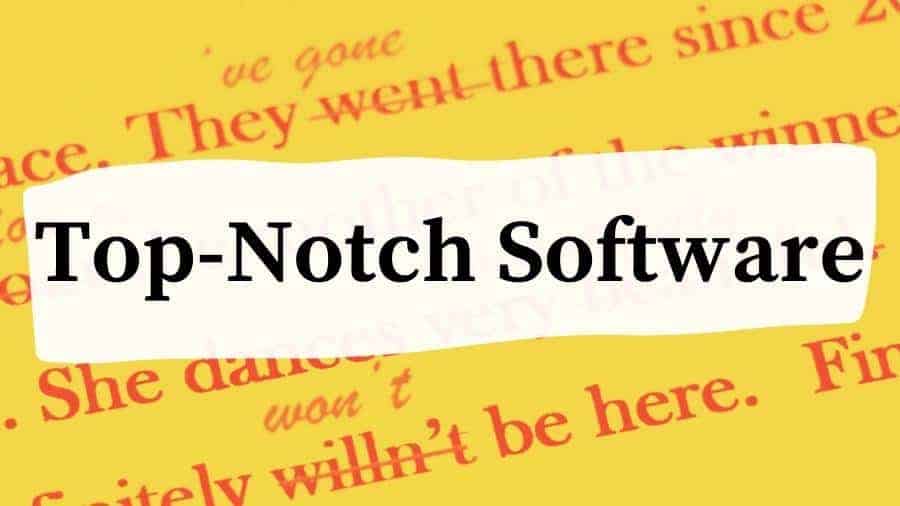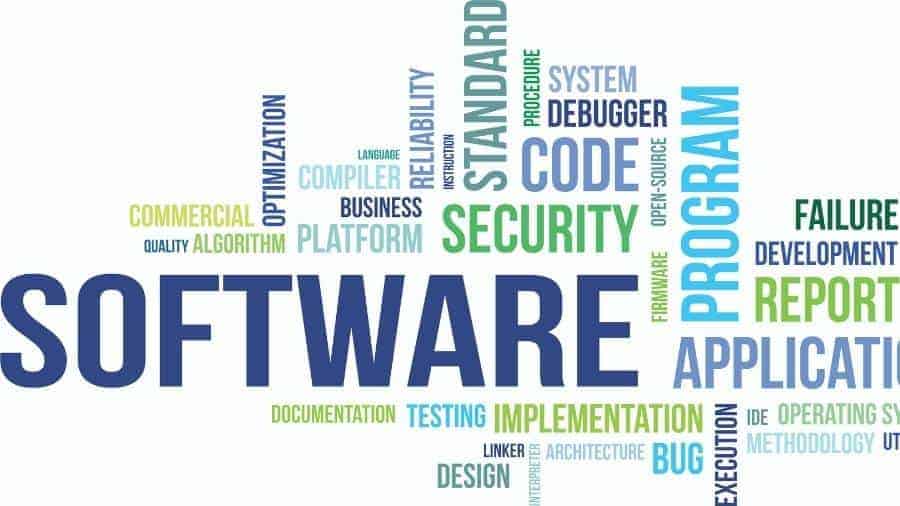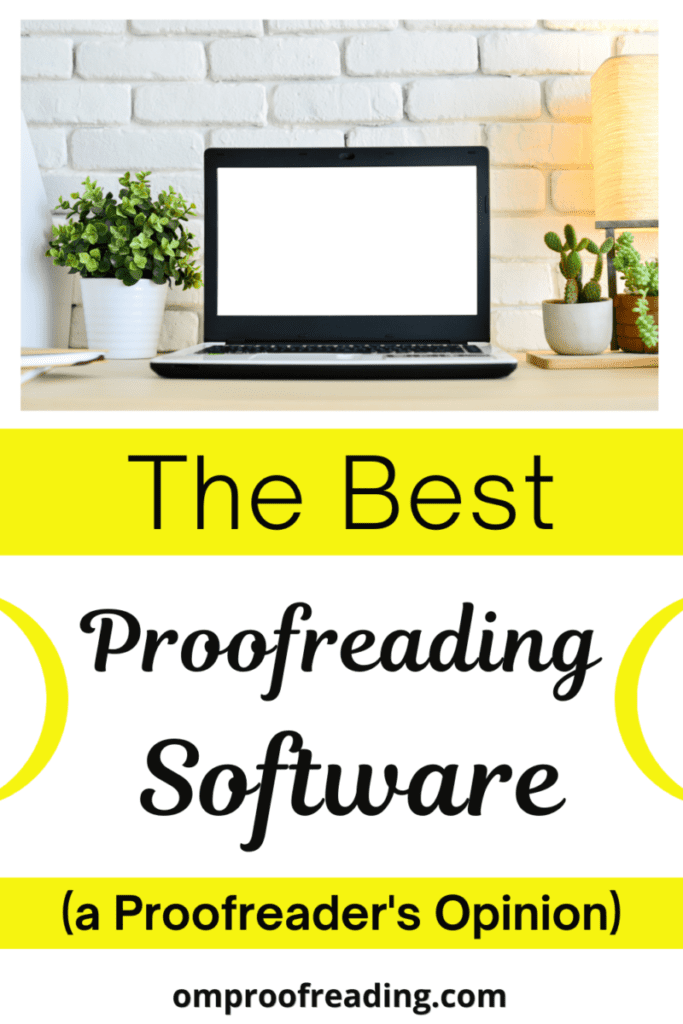This article may contain affiliate links. Please see our affiliate disclaimer in the footer menu for more information. Thank you for your support!

When it comes to the best proofreading software, we can divide the tools into two categories: essential and nonessential. Some software is a must to be able to do your job, while other software exists to improve your job performance and enable you to work faster.
For freelance proofreaders, Microsoft Word and Google Docs are the best word processors for proofreading due to their ease of use and popularity. Grammarly and PerfectIt are additional software programs that help proofreaders do their jobs with added speed and accuracy.
Let’s examine the pros and cons of each software so that you can choose what best meets your needs.
The Essential Proofreading Software
Proofreaders need to use at least one of the following three software programs:
- Microsoft Word
- Google Docs
- Adobe PDF
Knowing how to use more than one of these programs will allow you to serve a broader base of clients since some clients prefer to work in one of these programs over the other two. However, Microsoft Word is by far the most popular software for proofreading—preferred by proofreaders and clients.
Most of the documents I receive from clients are Word documents.
Microsoft Word Is a Winner
MS Word is a software that has been around for over thirty-five years. Proofreaders work with a feature in Word known as Track Changes. Track Changes lets you add or delete elements in a document, alter the formatting, and write comments in the margins.
Clients can easily see these suggested changes and comments.
You can purchase Word or use it for free online. I chose to buy the software so that I could have it available on my computer. If you’d like to do the same, you can visit Microsoft’s website to see the current price.
Pros of Microsoft Word
- tried-and-true software
- most commonly used software
- Track Changes is easy to learn and use
- one-month free trial available (for one of the subscription options)
Cons of Microsoft Word
- some clients won’t know how to use it
If a client doesn’t know how to use Track Changes, I send them a YouTube video that explains how it works.
Google Docs Is Great
Google Docs is another popular software in the realm of proofreading. Although it’s not used nearly as much as Word, it’s a great software to learn so you can collaborate with clients who prefer it.
In Google Docs, proofreaders work with the Suggesting feature—it works a lot like Track Changes. Also, like Track Changes, it’s quite easy to learn and use.

For clients, it’s a breeze. They simply accept or reject comments and suggested changes by clicking a check mark or an X.
Pros of Google Docs
- easy for clients to use
- no need to send file back to client (file stored online in Google Drive)
- free!
Cons of Google Docs
- not compatible with PerfectIt (but an add-on is now available)
PerfectIt gives you an add-on for Google Docs, free of charge. However, they don’t provide any support for the add-on. I’ve never tried it.
Here’s another way to get around the incompatibility issue:
- Copy and paste the document into Word.
- Run PerfectIt.
- Make the changes manually in the Google Doc.
These steps take a bit of time, but it’s an option.
Adobe PDF Is Admirable
I want to start by saying that I don’t use Adobe software.
However, proofreaders need to know it exists since you’ll have clients now and then who want you to proofread a PDF.
If you can provide this service, you’ll be able to attract a few more clients than other proofreaders who don’t proofread PDFs.
Two versions of Adobe PDF editor are available: Acrobat Standard DC and Acrobat Pro DC.
Adobe PDF editor makes use of what are known as PDF markup tools. These tools are similar to those used in Word and Google Docs; however, they are more difficult to learn.
Adobe is an awesome company that produces fantastic products.
However, when it comes to proofreading, the cost of owning an Adobe product may not be worth the reward.
If you plan to work in a publishing house, you may be required to use Adobe PDF editor. Just ask the publishing company you plan to work for about the software they use.
If you’d like to learn more about proofreading PDFs, I talk about it briefly in this article. I also mention a much cheaper (but not very intuitive) alternative for editing PDFs. It’s a software called iAnnotate.
I’ve never used it.
Pros of Adobe PDF
- enables you to proofread PDFs
Cons of Adobe PDF
- a bit expensive
- more difficult to learn than MS Word and Google Docs
Additional Proofreading Software

As mentioned earlier, a couple of other reputable products are available to help you with proofreading. Grammarly is the most commonly used software that falls into this category.
In reading numerous reviews of software for proofreaders, I found that Grammarly continually came out on top of its competitors, like Ginger, Hemingway Editor, ProWritingAid, WhiteSmoke, and others.
Grammarly is the most accurate proofreading software on the market.
PerfectIt is another software that is lesser known but very helpful. PerfectIt is your perfect partner when it comes to consistency.
Grammarly Is Gold
Good ol’ Grammarly. Who hasn’t heard of it? I love to use Grammarly (I use the premium version) because it gives me extra support. I run Grammarly after proofreading a text to see if I’ve missed anything. This software has often alerted me to errors I’ve overlooked. Phew!
I think Grammarly Premium is a wise investment for proofreaders. I came to this conclusion by putting both versions of Grammarly and Microsoft Word 365 Editor to the test.
If you don’t want to pay for the premium version, the other version of Grammarly is free. You don’t have to put in any credit card information to get the free version—you simply download it.
I highly recommend taking advantage of the free version of Grammarly, at the very least. Although it’s not as robust as the premium version, it’s well worth it to have it on hand.
I’m going to give you a few pros and cons here, and if you’d like more information, please feel free to check out the post I just mentioned.
Pros of Grammarly
- saves you time (You can use Grammarly at the beginning of the proofreading process to identify errors quickly, giving you more time to hunt down the remaining mistakes.)
- improves your job performance (You can run it at the end of the proofreading process to catch errors you may have missed.)
- free version is available
Cons of Grammarly
- sometimes makes erroneous suggestions
- problematic if you don’t have a decent grasp of grammar and punctuation (not a problem for proofreaders!)
- cannot read context well
PerfectIt Is Practical

PerfectIt is a unique software that focuses on checking consistency in a text. It ensures consistency for the following elements: hyphens and dashes, capitalization, spelling, abbreviations, numbers, and punctuation within lists and tables.
PerfectIt is especially beneficial for proofreading long pieces of writing since checking for consistency can be tiresome.
It also does the following:
- makes sure abbreviations are defined when first being used
- ensures brackets and quotes aren’t left open
- checks that figures and tables are numbered correctly and contain the necessary headings
- allows you to make style sheets to accommodate various house styles
Recently, they added a new feature for those who subscribe to The Chicago Manual of Style (CMOS) online. Subscribers can now use PerfectIt to check against the recommendations in CMOS. Nice!
Pros of PerfectIt
- saves you a lot of time when working on long documents
- very accurate
- free 14-day trial available (no strings attached)
Cons of PerfectIt
- only picks up on errors due to an inconsistency (not a grammar and punctuation checker)
- doesn’t work with Google Docs
I penned a post that goes into more detail about the pros and cons of PerfectIt if you’d like to learn more.
And Om Proofreading has an article about how Grammarly and PerfectIt stack up to each other if you’d like more information.
I hope this article has provided superb software suggestions for your proofreading needs.
Best wishes to you!
“Learn how to see. Realize that everything connects to everything else.”
– Leonardo da Vinci

